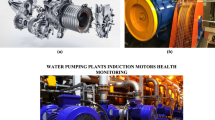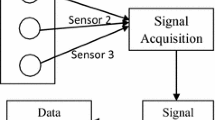Abstract
Condition monitoring of rotating machinery has attracted more and more attention in recent years in order to reduce the unnecessary breakdowns of components such as bearings and gears which suffer frequently from failures. Vibration based approaches are the most commonly used techniques to the condition monitoring tasks. In this paper, we propose a bearing fault detection scheme based on support vector machine as a classification method and binary particle swarm optimization algorithm (BPSO) based on maximal class separability as a feature selection method. In order to maximize the class separability, regularized Fisher’s criterion is used as a fitness function in the proposed BPSO algorithm. This approach was evaluated using vibration data of bearing in healthy and faulty conditions. The experimental results demonstrate the effectiveness of the proposed method.










Similar content being viewed by others
References
Burges, C. A. (1998). Tutorial on support vector machines for pattern recognition. Data Mining and Knowledge Discovery, 2, 955–974.
Chen, Y., Miao, D., & Wang, R. (2010). A rough set approach to feature selection based on ant colony optimization. Pattern Recognition Letters, 31, 226–233.
Du, S., Lv, J., & Xi, L. (2012). A robust approach for root causes identification in machining processes using hybrid learning algorithm and engineering knowledge. Journal of Intelligent Manufacturing, 23, 1833–1847.
Duda, R., Hart, P., & Stork, D. (2000). Pattern classification (2nd ed.). New York: Wiley.
Friedman, J. H. (1989). Regularized discriminant analysis. Journal of the American Statistical Association, 84, 165–175.
Gaitonde, V. N., & Karnik, S. R. (2012). Minimizing burr size in drilling using artificial neural network (ANN)-particle swarm optimization (PSO) approach. Journal of Intelligent Manufacturing, 23, 1783–1793.
Gryllias, K. C., & Antoniadis, I. A. (2012). A support vector machine approach based on physical model training for rolling element bearing fault detection in industrial environments. Engineering Applications of Artificial Intelligence, 25, 326–344.
He, Y., Pan, M., Luo, F., Chen, D., & Hu, X. (2013). Support vector machine and optimised feature extraction in integrated eddy current instrument. Measurement, 46, 764–774.
Howland, P., & Park, H. (2004). Generalizing discriminant analysis using the generalized singular value decomposition. IEEE Transactions on Pattern Analysis and Machine Intelligence, 26(8), 995–1006.
Jack, L. B., & Nandi, A. K. (2002). Fault detection using support vector machines and artificial neural networks, augmented by genetic algorithms. Mechanical Systems and Signal Processing, 16, 373–390.
Kennedy, J., & Eberhart, R. C. (1995). Particle swarm optimization. In Proceedings of IEEE international conference on neural networks, Vol. 4, pp. 1942–1948.
Kennedy.J, & Eberhart, R. C., (1997). A discrete binary version of the particle swarm optimisation algorithm. In Proceedings of the IEEE International Conference on Neural Networks (pp. 4104–4108). Australia: Perth.
Konar, P., & Chattopadhyay, P. (2011). Bearing fault detection of induction motor using wavelet and Support Vector Machines (SVMs). Applied Soft Computing, 11, 4203–4211.
Kudo, M., & Sklansky, J. (2000). Comparison of algorithms that select features for pattern classifiers. Pattern Recognition, 33(1), 25–41.
Kurek, J., & Osowski, S. (2010). Support vector machine for fault diagnosis of the broken rotor bars of squirrel-cage induction motor. Neural Computing & Application, 19, 557–564.
Khushaba, R. N., Al-Ani, A., & Al-Jumaily, A. (2011). Feature subset selection using differential evolution and a statistical repair mechanism. Expert Systems with Applications, 38, 11515–11526.
Li, R., Sopon, P., & He, D. (2012). Fault features extraction for bearing prognostics. Journal of Intelligent Manufacturing, 23, 313–321.
Li, Y., Tong, Y., Bai, B., & Zhang, Y. (2007). An improved particle swarm optimization for SVM training. Proceedings of the third international conference on natural computation (pp. 611–615). Los Alamitos: IEEE Computer Society.
Li, H., Lian, X., Guo, C., & Zhao, P. (2013a). Investigation on early fault classification for rolling element bearing based on the optimal frequency band determination. Journal of Intelligent Manufacturing. doi:10.1007/s10845-013-0772-8.
Li, Z., Yan, X., Tian, Z., Yuan, C., Peng, Z., & Li, L. (2013b). Blind vibration component separation and nonlinear feature extraction applied to the nonstationary vibration signals for the gearbox multi-fault diagnosis. Measurement, 46, 259–271.
Lin, S. W., Lee, Z. J., Chen, S. C., & Tseng, T. Y. (2008). Parameter determination of support vector machine and feature selection using simulated annealing approach. Applied Soft Computing, 8, 1505–1512.
Loparo, K. A. (2012). Bearings Vibration Data Sets, Case Western Reserve University: http://csegroups.case.edu/bearingdatacenter/home.
Mallat, S. G. (2003). A wavelet tour of signal processing. The sparse way (3rd ed.). New York: Academic Press.
Mortada, M. A., Yacout, S., & Lakis, A. (2013). Fault diagnosis in power transformers using multi-class logical analysis of data. Journal of Intelligent Manufacturing,. doi:10.1007/s10845-013-0750-1.
Park, C. H., & Park, H. (2007). A comparison of generalized linear discriminant analysis algorithms. Pattern Recognition,. doi:10.1016/j.patcog.2007.07.022.
Qian, Y., Xu, L., Li, X., Lin, X., Kraslawski, L., & Lubres, A. (2008). An expert system development and implementation for real-time fault diagnosis of a lubricating oil refining process. Expert Systems with Applications, 35(3), 1251–1266.
Rafiee, J., Arvani, F., Harifi, A., & Sadeghi, M. H. (2007). Intelligent condition monitoring of a gearbox using artificial neural network. Mechanical Systems and Signal Processing, 21, 1746–1754.
Rafiee, J., Rafiee, M. A., & Tse, P. W. (2010). Application of mother wavelet functions for automatic gear and bearing fault diagnosis. Expert Systems with Applications, 37, 4568–4579.
Randall, R. B., Antoni, J., & Chobsaard, S. (2001). The relationship between spectral correlation and envelope analysis in the diagnosis of bearing faults and other cyclostationary machine signals. Mechanical Systems and Signal Processing, 15(945–962), 2001.
Randall, R. B. (2011). Vibration-based condition monitoring: Industrial, aerospace and automotive applications. New York: Wiley.
Samanta, B., Al-Balushi, K. R., & Al-Araimi, S. A. (2001). Use of genetic algorithm and artificial neural network for gear condition diagnostics. Proceedings of COMADEM, (pp. 449–456). University of Manchester, UK.
Samanta, B., Al-Balushi, K. R., & Al-Araimi, S. A. (2003). Artificial neural networks and support vector machines with genetic algorithm for bearing fault detection. Engineering Applications of Artificial Intelligence, 16, 657–665.
Samanta, B., & Nataraj, C. (2009). Use of particle swarm optimization for machinery fault detection. Engineering Applications of Artificial Intelligence, 22, 308–316.
Sharma, A., & Paliwal, K. K. (2012). A new perspective to null linear discriminant analysis method and its fast implementation using random matrix multiplication with scatter matrices. Pattern Recognition, 45, 2205–2213.
Scholkopf, B. (1998). SVMs-a practical consequence of learning theory. IEEE Intelligent Systems, 13, 18–19.
Sheen, Y. T., & Liu, Y. H. (2012). A quantified index for bearing vibration analysis based on the resonance modes of mechanical system. Journal of Intelligent Manufacturing, 23, 189–203.
Shen, C., Wang, D., Kong, F., & Tse, P. W. (2013). Fault diagnosis of rotating machinery based on the statistical parameters of wavelet packet paving and a generic support vector regressive classifier. Measurement, 46, 1551–1564.
Soong, T. T. (2004). Fundamentals of probability and statistics for engineers. New York: Wiley.
Stepanic, P., Latinovic, I. V., & Djurovic, Z. (2009). A new approach to detection of defects in rolling element bearings based on statistical pattern recognition. International Journal of Advanced Manufacturing Technology, 45, 91–100.
Sun, W., Chen, J., & Li, J. (2006). Decision tree and PCA based fault diagnosis of rotating machinery. Mechanical Systems and Signal Processing, 21, 1300–1317.
Teti, R., Jemielniak, K., O’Donnell, G., & Dornfeld, D. (2010). Advanced monitoring of machining operations. CIRP Annals—Manufacturing Technology, 59, 717–739.
Vapnik, V. N. (1995). The nature of statistical learning theory. New York: Springer.
Wang, C. C., & Too, G. P. J. (2002). Rotating machine fault detection based on HOS and artificial neural networks. Journal of Intelligent Manufacturing, 13, 283–293.
Yuan, S. F., & Chu, F. L. (2007). Fault diagnosis based on particle optimization and support vector machines. Mechanical Systems and Signal Processing, 21(4), 1787–1798.
Yang, B. S., Han, T., & Hwang, W. W. (2005). Fault diagnosis of rotating machinery based on multi-class support vector machines. Journal of Mechanical Science and Technology, 19(3), 846–859.
Yang, Y., Yu, D., & Cheng, J. (2007). A fault diagnosis approach for roller bearing based on IMF envelope spectrum and SVM. Measurement, 40, 943–950.
Yang, Z. L., Wang, B., Dong, X. H., & Liu, H. (2012). Expert system of fault diagnosis for Gear Box in wind turbine. Systems Engineering Procedia, 4, 189–195.
Ye, J., Janardan, R., Li, Q., & Park, H. (2004). Feature extraction via generalized uncorrelated linear discriminant analysis, In The Proceedings of the international conference on machine learning, pp. 895–902.
Ye, J., & Xiong, T. (2006). Computational and theoretical analysis of null space and orthogonal linear discriminant analysis. Journal of Machine Learning Research, 7, 1183–1204.
Yu, H., & Yang, J. (2001). A direct LDA algorithm for high-dimensional data-with application to face recognition. Pattern Recognition, 34, 2067–2070.
Zhang, Y., Zuo, H., & Bai, F. (2013a). Classification of fault location and performance degradation of a roller bearing. Measurement, 46, 1178–1189.
Zhang, Z., Wang, Y., & Wang, K. (2013b). Fault diagnosis and prognosis using wavelet packet decomposition, Fourier transform and artificial neural network. Journal of Intelligent Manufacturing, 24, 1213–1227.
Acknowledgments
This work was completed in the laboratory of applied precision mechanics LAPM (University of Setif1, Algeria). The authors would like to thank the Algerian Ministry of Higher Education and Scientific Research (MESRS) and the Delegated Ministry for Scientific Research (MDRS) for granting financial support for CNEPRU Research Project No. J0301220120001. The authors would like to thank Professor K. A. Loparo of Case Western Reserve University for his kind permission to use their bearing data.
Author information
Authors and Affiliations
Corresponding author
Rights and permissions
About this article
Cite this article
Ziani, R., Felkaoui, A. & Zegadi, R. Bearing fault diagnosis using multiclass support vector machines with binary particle swarm optimization and regularized Fisher’s criterion. J Intell Manuf 28, 405–417 (2017). https://doi.org/10.1007/s10845-014-0987-3
Received:
Accepted:
Published:
Issue Date:
DOI: https://doi.org/10.1007/s10845-014-0987-3




